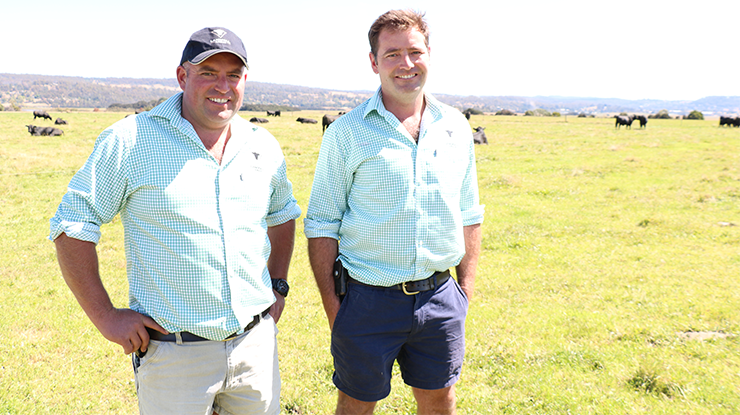 Ed and Frank Archer on their family property, ‘Landfall’.
Ed and Frank Archer on their family property, ‘Landfall’.
On target to speed up genetic gain
Tasmanian cattle producers, the Archers, have used assisted reproductive technologies (ART) in their ‘Landfall’ Angus seedstock herd for more than 30 years to accelerate genetic gain.
Gerald Archer – father of Landfall’s current co‑principals Ed and Frank – started using embryo transfer technology in the mid‑1980s to duplicate their own genetics and to introduce genetics from outside their herd.
“Then, in the mid‑1990s, Dad brought in some embryos from the US, which we put into our recipient cows,” Frank said.
“We flushed the resulting females at 13–14 months of age, which shortened the generational interval massively and allowed the duplication of those genetics within our herd.”
While they do continue to buy embryos from other producers, the Archers’ main focus is to identify and multiply the elite genetics within their own herd.
The Archers have seen a significant impact from using multiple ovulation embryo transfer (MOET) to duplicate elite genetics as it allows them to accelerate the rate of genetic gain and open new opportunities to utilise all their cattle for superior livestock production.
“With our program, we take the top 2% of our elite female cows each year and aim to collect 500–550 embryos from these, which will go into the bottom 20% of our cows.
“So even though these recipient cows don’t meet the Landfall criteria to remain a seedstock female, they’re still having genetically superior calves,” Frank said.
“Embryo transfer also allows us to cull heavily on our females without the costs associated with this, because we aren’t removing them from our system altogether, but are simply shifting them sideways into the recipient herd.”
This creates a flow‑on effect for the wider industry by accelerating genetic gain for their clients’ herds.
“This is of increasing importance because, for a profitable and sustainable industry, we need to concentrate on the impact of our own decisions up and down the value chain, and how they can benefit everyone from the breeder right through to the consumer,” Frank said.
Looking ahead
Although the Archers recognise the potential of IVF, they haven’t adopted it yet because the current pregnancy rates achieved are too low for their program.
“In our MOET program, over the last five years we’ve achieved a minimum of 79% conception rate, and it’s been as high as 86%,” Frank said.
“With IVF, I’ve been quoted much lower conception rates, which would compromise our overall breeding program.
“We see the many benefits from the use of IVF, but within our program overall, where we’re aiming to restrict our joining period to six weeks, we can’t afford to recycle our recipients too many times.
“We look forward to the IVF technology improving to the point where we can achieve a balance with the pros and cons.”
|
Lessons learned
|



